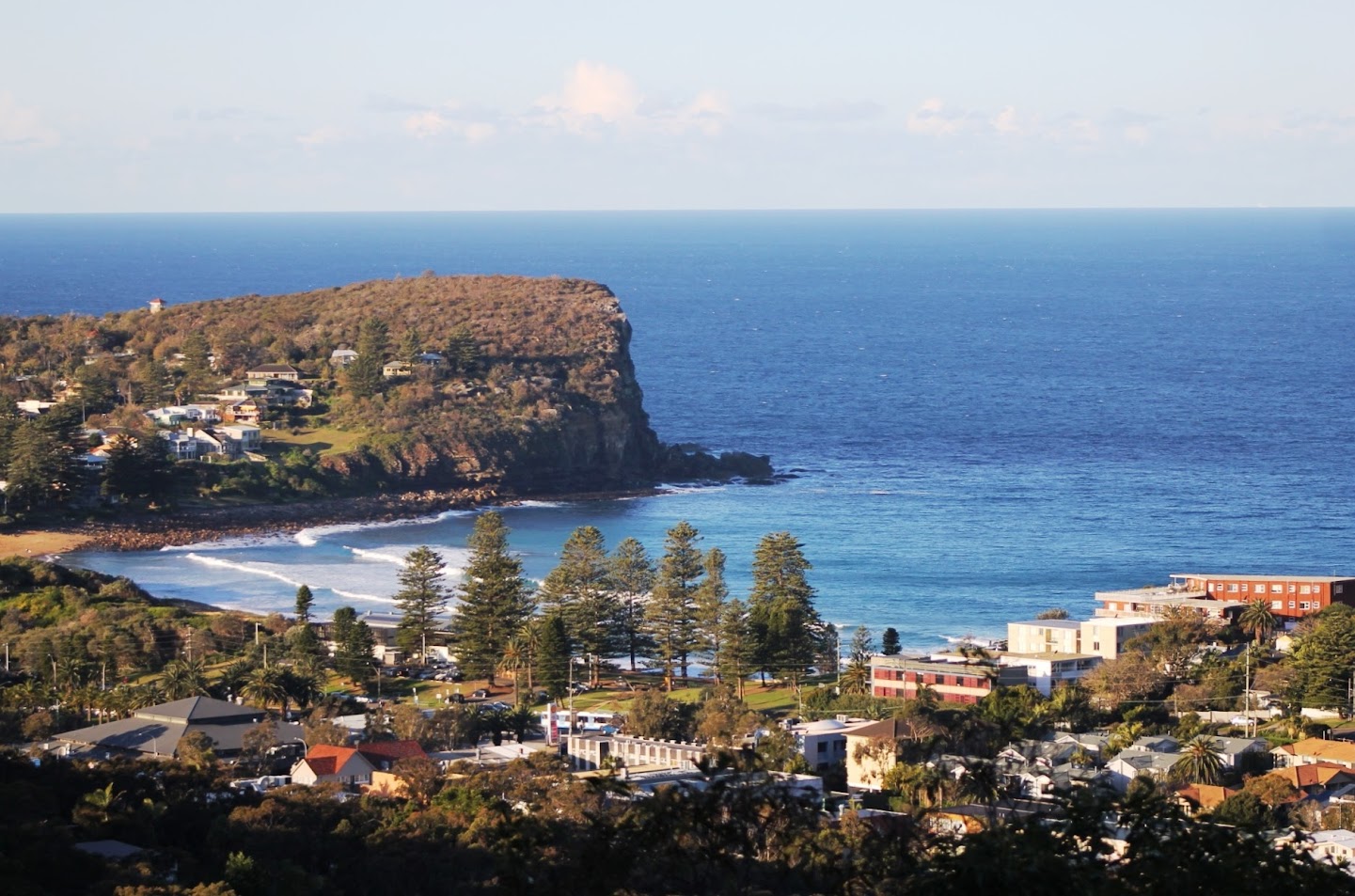March 24-30, 2024: Issue 619
Roy G. Smith
Roy Smith had his 100th birthday on March 4 2024. A wonderful party was held where children, grandchildren and great grandchildren, along with neighbours, gathered to toast the centenarian and have a mouthful of a chocolates laden cake.
Cards were sent in from His Majesty King Charles III, the Australian Prime Minister, The Hon. Anthony Albanese, NSW State Premier, The Hon. Christopher Minns, the Governor General of Australia, His Excellency General the Honourable David John Hurley AC DSC (Retd), Her Excellency the Honourable Margaret Beazley AC KC, Governor of New South Wales, and Mackellar MP Dr. Sophie Scamps, along with birthday greetings from a thousand Pittwater residents. Roy lives in Avalon Beach with youngest daughter Debbie Mundell, and despite the English accent, has been a dedicated Australian for 62 years.
From being a World War 2 pilot to taking up pottery at the age of 98, Roy remains sharp as a tack and an inspiration to his family and community.
This Issue a few insights into his first 100 years, with thanks to Brian Friend OAM, a fellow ‘planes and pilots fan’, who assisted with the interview.
You were born on the 4th of March 1924 - where were you born?
In Brighton, Sussex, England.
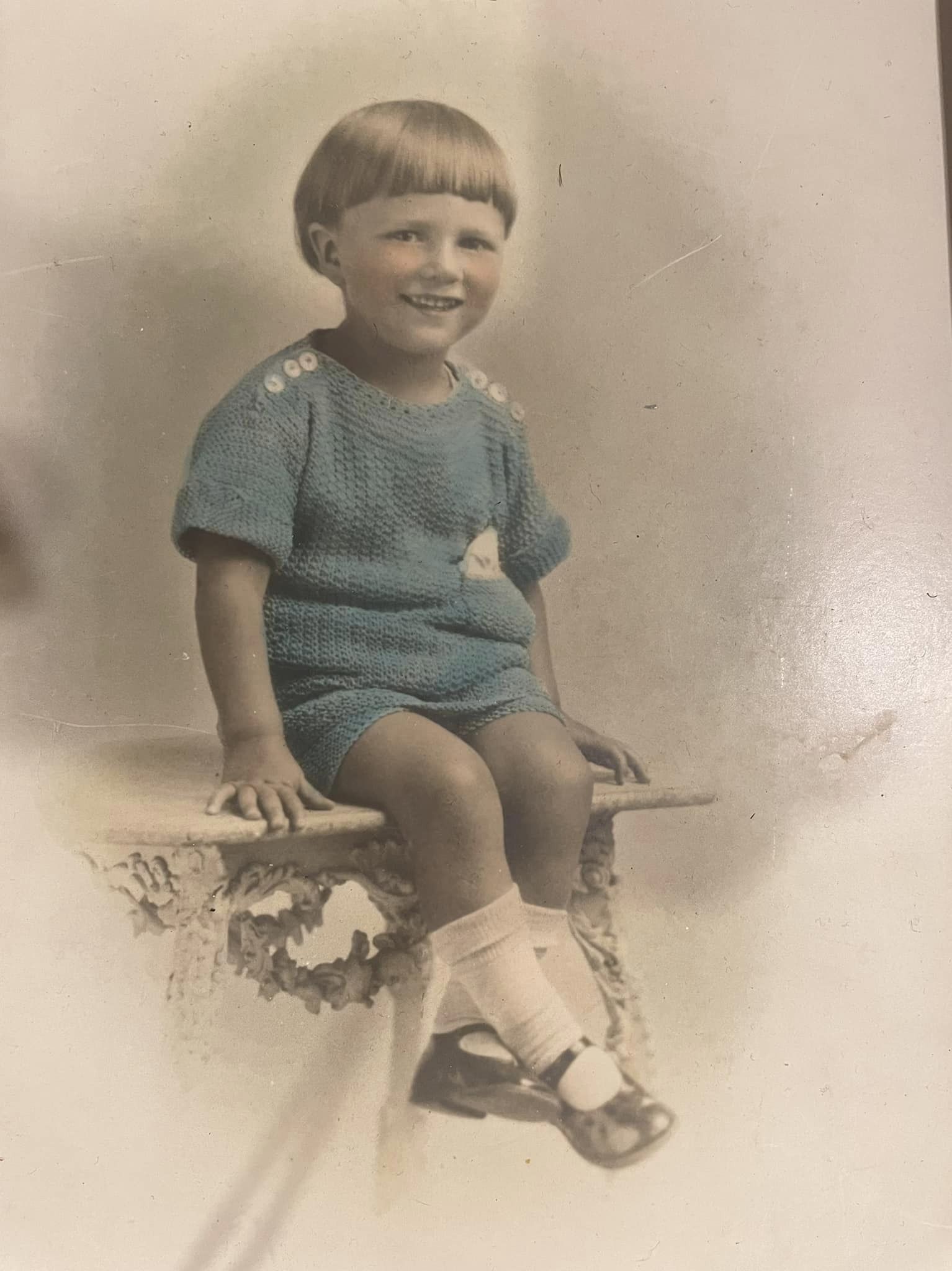
Roy, aged 2 and a 1/2
Did you grow up there?
I stayed in Brighton until I was 6. My father was a Headmaster and his school was up in London, so he had an awful journey everyday going from the south coast up to London, it was about 5 hours travelling. He got fed up with this and so bought a house up in the Middlesex part of London. We moved up there and lived there right up to the time I went into the RAF.
Was there a local playground – what did you do for fun?
In those days there were very few facilities. Luckily I had a very good school and happened to be quite good at sport and so spent a lot of time on the athletics field and playing rugger. Running was my speciality and I managed to break a few records in this at school. Young children could walk around in those days without being in any danger, even at the age of 5 I would walk to school myself; I’d go to school, come back for lunch, and then return.
Life was really lived outdoors. We had no radio, no phone in the house when I was young and no electricity, we only had gas, and so no electrical appliances at all. We had gas lighting, little mantels that would light up, even the street lighting was via gas then. The street lighting man used to come along and light the lamps. So it was quite a different world then.
What school were you going to?
When in Brighton I was just a little local primary school, around half a mile away. When I moved up to London I went to one of the government public schools called Harrow County Grammar School for Boys, and I’m still a Member of the Old Boys for that school, we’re called ‘Old Gaytonians’ and that’s because it was on a road called ‘Gayton road’. They put a post up on my birthday saying ‘he’s the oldest Gaytonian’. I’ve been searching for years to find anyone of my era but there’s nobody pre-war at the school.
It was a beautiful childhood because it was all outdoors and sport.
How did you come to join the RAF?
At the age of 15, which was 1939, the war started. My father’s school was evacuated from London because of bombing. He didn’t want to leave us alone so we all moved down to the south coast, Brighton, back to where we came from. So I had to leave school at 15, having gained my School Certificate before I left.
I worked down there for a year for an insurance company and things quietened down a bit until Dunkirk and the evacuation from there. Brighton suddenly became a target as all the little boats were coming in with all the troops and the Germans were coming off trying to pick them off.
In the period from the second half of 1940 to 1941 there were 40 thousand civilians killed in the London area alone from bombing, over just that 7 months.
However, we moved back to London because Brighton was really becoming too hot as a target by the Germans. I met my second wife during this time, we were teenage sweethearts over the war years. We’d go out and see the dogfights overhead between the Germans and those defending Britain. These were taking place everyday. I suddenly thought ‘I’d love to be a pilot’ – I was only 17 then.
My mother had gone away for a few days to visit family in Brighton so I went up to Air Ministry in London and joined the Air Force as Air Crew. Air Crew had to be volunteers – you couldn’t be conscripted into Air Crew. You couldn’t be called up to do that until you were 18, and I was 17.
On August 21st 1941 I was signed on. They said ‘go back home, you will hear from us in a few months about what we’re gong to do.’
A few months later a letter came in the post and they were sending me up to St. Andrew’s University, where I would undertake a 6 months course learning RAF things such as navigation, mixed in with university subjects. I went up there from April through to October, it was marvellous, a wonderful experience.
Friendly: Did you have Air Cadets when you were at School?
When I was waiting to join the RAF, even though I had left school, I went back and joined the Air Squadron Corps, the ATC for kids, and became a Corporal there. My Maths Master at school happened to be the Honorary Squadron Leader running the unit. He knew me well as Maths was my subject. So I’d already had an elementary training.
After 6 months at the university, I was then old enough to go into uniform. I became what is a Leading Aircraftsman, an LAC. I was in the broad category ‘Air Crew’ – that covered everything; gunners, wireless operators, navigators, flight engineers, pilots – the whole gamut. You had to be graded to see what role you were suited for – all of us wanted to be pilots but only a small amount could be pilots because the rest of the crew also had to be made.
We were sent up to Carlisle for what’s called ‘Grading School’. They had Tiger Moths, the old biplane ones, and you had 10 hours flying, and in that time you had to try and solo. Then they could see if you were really had potential to be a pilot or not.
For some reason, perhaps because I was a sporting bloke I think, I broke the record and did it in 4 hours and 50 minutes. That surprised them a bit – surprised me too. (laughs)
We finished at Grading School and then had to wait to see who had been selected, as you weren’t told then whether you had been or not. We were all sent down to Brighton funnily enough, where I was born, and all the aircrew were housed in all the hotels along the sea front, they took up all of them.
We were all called out and the Officer said, ‘right, this is what you are all going to be…’ He then went right through the list of names; so and so; navigator, so and so; flight engineer… then he got to Smith; Pilot!
I thought, ‘great, I’ve done it, I’ve done it!’.
I was then put into a different category, where all the Pilots were gathered, and we were sent up to Manchester. They couldn’t do Pilot training in England because the Germans were picking off planes all the time; you wouldn’t have lasted 5 minutes as you were sitting ducks as trainees.
First of all they kitted us out with khaki and said ‘you’re going to South Africa to do your training’, as there were schools in Africa. That didn’t go down too well, but we were then taken up to near Glasgow to the docks, waiting for the cruise ship to come in to take us there.
At the last minute an Officer called us in and said, ‘sorry chaps, you’re not going to South Africa, we can’t get you on the boat so you will have to come back and wait for another one.’
We all groaned and moaned but this was a lucky happenchance. That boat went out in a convoy and about 2 weeks later we heard it had been torpedoed and nearly all those aboard had been killed. This was just before Christmas in 1942.
Two weeks later we returned and this time were told we were going to be trained at a school in America. This was much better.
The boat we went out on was the Queen Elizabeth; she’d only just been finished before the war and hadn’t done any private trips – we were the first ones on. So we had this beautiful Queen Elizabeth and only about 500 of us on board as the only ones going that way were those going out to do training.
She could do around 35 knots – they stripped her of all her stabilisers, so no other boats could keep up with her, and so we went out on our own. She went full blast and we did a zigzag all the way over. We all had to take turns looking for periscopes. We had turns of duty on deck, so there were lots of eyes looking around to see if w could detect any U-boats.
We got over there in about 3 and a bit days. We went to Halifax in Canada, as that was the reception area, and from there put us on trains and we went right the way across America to just outside Phoenix, Arizona to a place called ‘Mesa’ and Falcon Field. At that time the Brits had about 5 British Flight Training Schools, they were called ‘BFTS’s, and we were Number 4 BFTS.
Arizona: Roy is flying plane furthest out.
The first training we did was on Stearmans; you probably saw a Stearman turn itself upside-down at Shellharbour about a week ago. That is one of only 30 Stearmans that are here in Australia.
The training there took 6 months. The first half was on Stearmans, that was the elementary bit, and then we moved over to AT-6’s, which is very similar to the Harvard, which is a fighter trainer.
We completed different courses. I went on an acrobatic course, learned all the different manoeuvres. A strafing course, which was flying down and hitting targets on the ground. And then a dogfight course, where we’d go up in pairs and have a dogfight to see who could get on the other one’s tail. All that instructing for us was because we were being trained to be fighter pilots; that’s what we thought.
I got my wings in 1943.
Roy getting his RAF 'wings'
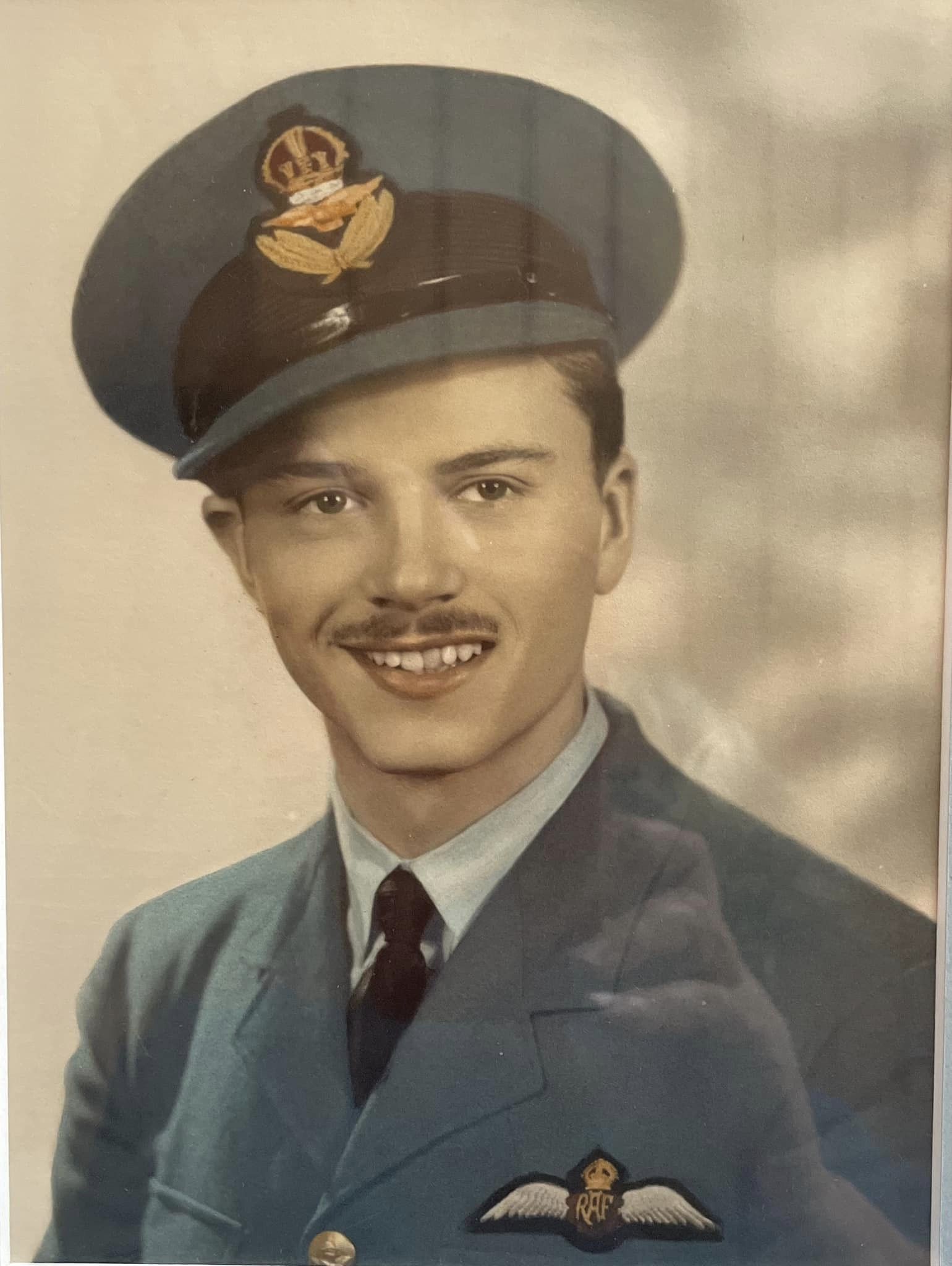
Roy Smith in uniform with his RAF wings
Being in America – any adventures?
Yes. We used to pop over in our breaks to Hollywood to the Hollywood Canteen, which was run by the movie stars of then. They would feed you up to the gills and then the stars would come out and dance with you. I danced with Joan Leslie and met Gracie Fields. She was marvellous – she took me home and I spent the night in her house. She was singing songs to us all the time. There was Marlene Dietrich and people like Monty Woolley, Carmen Miranda and Mickey Rooney, who was a young boy then with chips on his shoulder. So we did have a bit of fun while we were there.
We went out on the Queen Elizabeth and came back on the Queen Mary. So I’ve been on both of them. Only this time, instead of 500 on board, we had thousands American troops. We were bringing them all over – they were having to sleep in shifts as there weren’t that many bunks aboard – so we had 3 eight hour shifts. It was quite extraordinary.
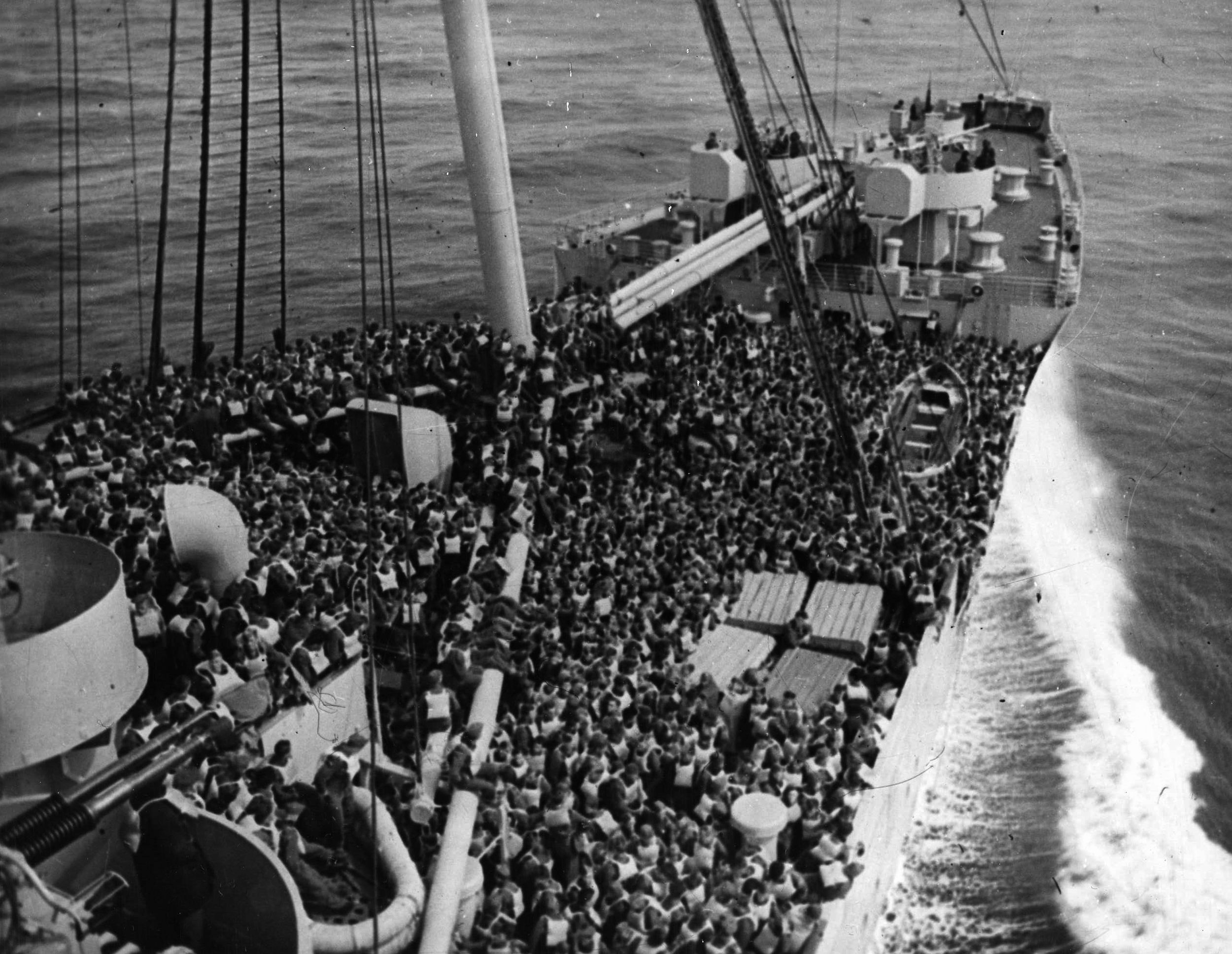
Troops on deck during a lifeboat drill aboard the Queen Mary, December 1944.
So you were put into bombers on your return to England?
When I got my wings and we went back to England, all of us were expecting to be put in Spitfires or Mosquitoes, or something like that. However, they lined us all up and said ‘sorry chaps, we’re not losing many fighter pilots at the moment, we are losing lots of bomber pilots.so you will all have to convert over to multi-engines and be bomber pilots.’
We had no choice, we were just pitch-forked into it. Everybody groaned like mad; we’d all been looking forward to getting our singles, but anyway, that’s what was needed by then.
They put me into No. 1 Group, which was in Lincolnshire at a place called RAF Hemswell, which were Lancasters. Although you can’t go straight from a single-engine to a four-engine one they gave us some grounding there on what to expect and we went up and did some flying.
After about 2 months there we were called before Group again; ‘sorry chaps, you’re not going to stay in this group, you’ve got to switch over to No. 38 Group as we’ve started up what is called ‘Strategic Air Force’’.
They were in urgent need of pilots. This was a Halifax group, they flew Halifax 4-engine bombers, but this wasn’t bombing; the Strategic Air Force was all low level work; towing gliders, dropping paratroopers, dropping supplies, dropping SAS. This was heading into 1944, and I was 20 years old in March 1944.
So they put us through what was called Advanced Flying School and that was flying Airspeed Oxfords. These were a small twin-engine plane. Having gone through that we then had to move on to the OTU, the Operational Training Unit, and there we were on big two-engine planes, the Armstrong Whitworth A.W.38 Whitley. At that stage I got crewed up and chose my navigator, flight engineer, gunner and all that. We all got together at OTU, did the course at OTU where we did dragging gliders and dropping paratroopers and equipment. We then had to move on to the Heavy Conversion Unit, which was another airfield and where they had the 4-engine Halifax's, and where I learned to fly the 4-engine plane. There we learnt to tow the bigger things.
We then went down what they called the Operation Refresher Training Unit where the gunners were given practice at firing at targets while we were flying and we polished up on our towing techniques. By then we were towing very heavy aircraft. We were then put on standby to go into a squadron when one called for replacements.
That took us into the start of 1945, and so we were getting near the end of the war.
Then I joined the squadron at Tarrant Rushton, No. 298, which was based down on the south coast near Bournemouth. This was the only airfield that could tow the Hamilcar glider. This was a huge glider; it carried the Tetrarch tank, the whole tank went inside it, plus a jeep with a full crew, and the gun. The weight was enormous.
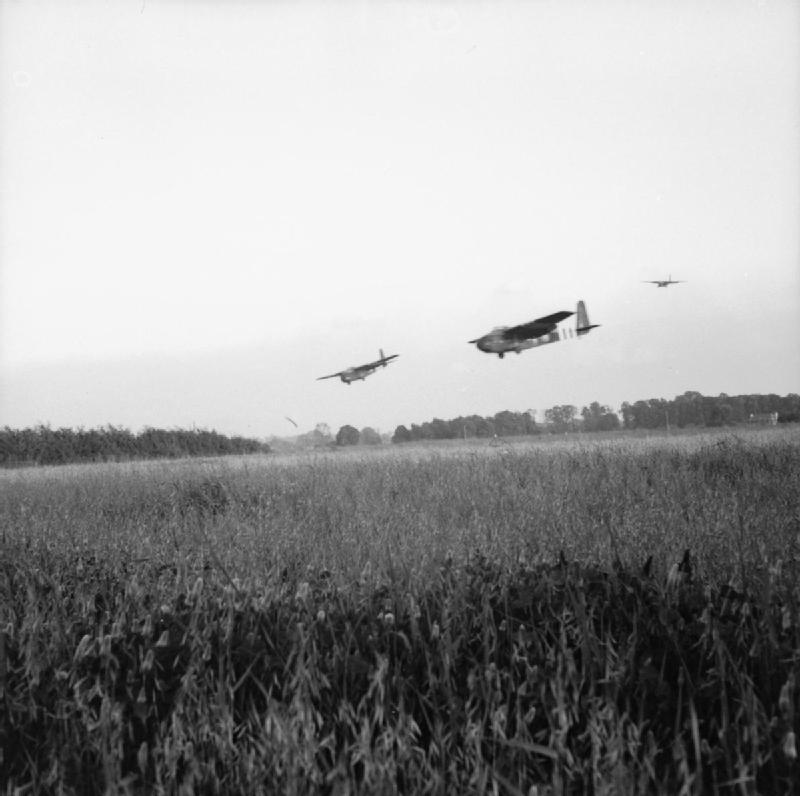
Hamilcar gliders of 6th Airlanding Brigade arrive on Drop Zone 'N' carrying Tetrarch tanks, 6 June 1944, Normandy. Photo: Christie (Sgt), No 5 Army Film & Photographic Unit. This photograph, B 5198, comes from the collections of the Imperial War Museums.
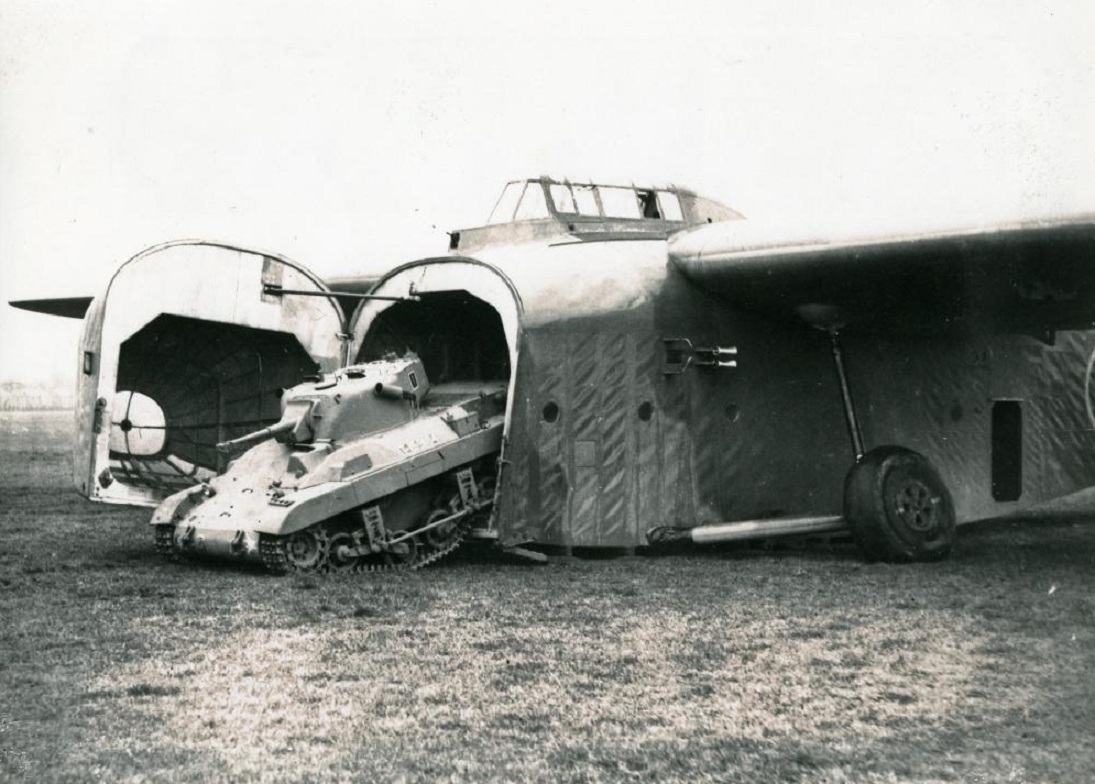
M22 Locust tank leaving a Hamilcar glider.
Friendly: having seen photographs of those I couldn’t understand how they could get them off the ground.
That’s when we had fun and games. I happened to be good at night-landing, and you must understand that at that time England was in total blackout, you weren’t allowed to show any light and it was absolutely pitch dark, so at night-time you were literally blind. We had to train with the glider pilots – and those that came in were beginners – and we had to teach them night-flying.
I happened to be good at night-landing for some reason, I just had a knack. And so they said ‘look, we’re going to sign you up to train these pilots’ – it was just a case of circuits and bumps. It was just one after another of picking them up and dropping them off, but taking into account these absolute beginners didn’t know the distance between their wheels and the ground. We’d link up the cable, and take off going down the runway carrying a very considerable weight.
They would always get airborne first because of their wing loading and they’d get up, and if they weren’t experienced, they’d lose their position. If they got too high they used to drag my tail right up and my nose would be going down like that – I’d be going along the runway trying to pull it back as I couldn’t take the plane up. You’d have to yell down the radio – I won’t use the language we sometimes had to employ, but you get what was happening…. we’d tell them to get down, and then we’d get up and get them off. Worse than that was if they lost their position and drifted over to the side, which was very easy to do. They’d drag your tail like that, and the next moment you’d be off the runway and be tearing over all the rough stubble. There were pillboxes everywhere with machine guns in them and you’d just keep your fingers crossed that you wouldn’t hit one of those. We could take off, but it was a very bumpy take-off.
They were dependent on me but at the same time I was dependent on them. With their weight, once we got up there and at good flying speed, they could still give you a very rough journey as they could pull you all over the place. So it was quite a bit of training we had to give them; the poor devils. I would never have been a glider pilot because once you got them to their dropping zone - and there was a written rule where you never cast a cable, they had to do it – they would drop it when they saw fit – we would tell them ‘were here, we’re over the target’ and they would drop. Once they left the plane they had no power and the only way they could go was down. They had to find the right spot to put it and not hit a tree or a building – if they made a mistake there was no going back as they had no power. Those chaps; I take my hat off to them.
That went on to the end of the war. That was my job, being part of the instructing flight.
Roy (at left with hat on) with his crew
Seconded to the Far East: June 1945
At the end of the war in Europe we were told we were going out to the Far East to do an airborne assault on Singapore. They had no facilities out here and we were an expert squadron. So in June 1945 the squadron went out in 3 waves.
The Far East Squadron - Roy is at the front
I was on the third wave. I picked up a brand new Halifax plane before we left. Most of my crew were around my age – the oldest was my Flight Engineer, and he was 21. The Navigator was 21, I was only just 21 and the others were only 18 and 19.
We took off from Tarrant Rushton and from there went to Tel Aviv. In both places I had oil leaks in the engines and I was grounded for a few days while they repaired the leaks.
From Tel Aviv we flew on to Iraq, to Shaibah Iraq, the hottest place on earth, it’s never less than 120 Fahrenheit, just scorching, it’s just desert. As we were getting up towards it one of my engines was completely jammed fully open. We couldn’t do a thing with it; we tried feathering it, shifting it, it wouldn’t move, and was just full blast.
I contacted them and spoke to the Engineering Officer there and told them we had problems. We came down, and I had my crew in crash positions, and I had my Flight Engineer cut the engine completely. We didn’t want to do it too early as without feathering it would windmill and cause enormous drag – and it was the outer engine, which would cause more drag, and I had a very heavy load on board, we were full with all sorts of stuff we were taking out to the squadron. So I wanted to leave it until the last minute.
Unfortunately, two things went wrong. As we touched down it didn’t cut straight away, it still kept going. I tried to keep the opposing one on too to keep it level, but we did a slight swing. Normally with the Halifax, which had a solid aluminium casting, and a very strong undercarriage, you could swing it without any problem. It turned out afterwards that one of my legs had a fault in it, a faulty casting, which weakened the leg and it dropped off. Therefore we were going along for a time on one leg. Ultimately there was nothing I could do; the wing tip hit the ground and then we just cartwheeled.
The crew got out and moved about a hundred yards away, took one or two pictures, and then one of them suddenly said ‘where’s the Skipper?’.
They realised I wasn’t with them. I had somehow got tangled up in my seatbelt and couldn’t get out. My mind went blank; and I don’t know how I did it, but somehow I made my way out. They think I used my leg because my whole right shin was damaged.
I got halfway to them and the whole thing blew up. There was not much left of it. I was stuck in hospital at Shaibah for a few weeks after that.
I then hitchhiked with an American Liberator that came through – my target was Karachi, the squadron was based there.
I caught up with my crew in a province called Central Jaipur and we were tasked with internal flights at that time, doing supply drops. The Americans had brought the war to an end, so we didn’t have to do the airborne assault on Singapore, but they wanted us to stay and drop supplies because all the villages in North Burma were starving – the Japanese had raided them and taken everything and thy had no food at all. They were all stuck among the areas at the base of the Himalayas.
We moved a flight down to a place called Meiktila, which is in central Burma, and from there did supply dropping. We were carrying about six tonnes of rice in sacks and dropping it, which saved the lives of these villagers as it gave them food.
getting food to the hungry
Even that had its excitements. We had another squadron join us at Meiktila, No. 10 Squadron. They only flew Dakotas, DC3’s, twin-engines. They didn’t have the power in their engines that we had. On one occasion 3 of them were flying up one of these steep canyons and suddenly found they had taken the wrong one as they came around a bend. There was just a dead wall ahead of them and they went smack into it and killed everybody – three whole crews wiped out.
If it had been a Halifax we would have been able to climb right out, but they couldn’t. So that was very tragic, very upsetting.
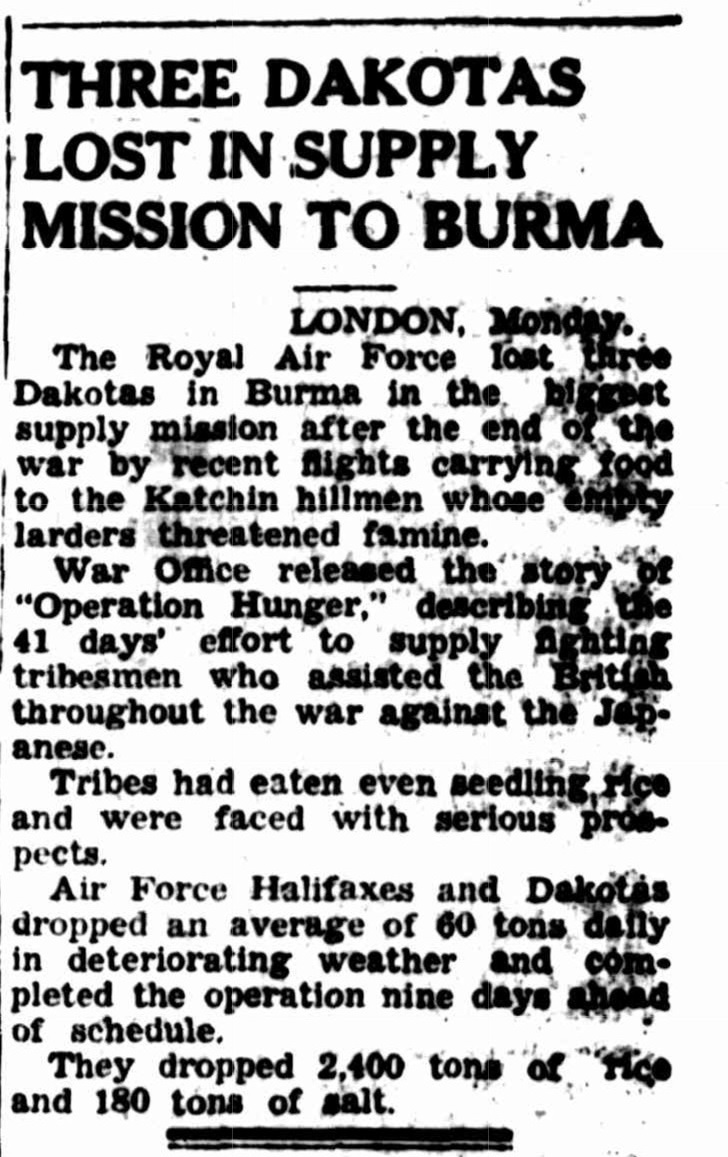
THREE DAKOTAS LOST IN SUPPLY MISSION TO BURMA (1946, June 11). The Canberra Times (ACT : 1926 - 1995), p. 1. Retrieved from http://nla.gov.au/nla.news-article2686148
We also did what was called the ‘hump route’ over the Himalayas. I used to fly from a place called Digri, which is outside Calcutta, over the Himalayas to a place called Kunming, which is up in the mountains and over in China. It’s 6000 feet up with a big lake but is surrounded by the Himalayas.
It was very tricky. We had to design the descent – you had to be very accurate with it. It was alright if it wasn’t cloudy. If it was cloudy, and you were doing it via instruments, it was a bit dicey. A month before I did it an American Liberator took the wrong turn and went into the mountain. Apparently it caused a bit of a landslide when it exploded which damaged quite a few houses in the village below.
I did a few of those. Our safety eight was 17,000 feet for this route, and the Halifax had a maximum ceiling of 22 thousand feet – the English bombers of then couldn’t go high like modern aircraft – I had 4 radial engines each one of 2000 horsepower. It was very powerful, but it couldn’t get the elevation. We used to go over at 22 thousand, but that was still clear by 5 thousand and that was great.
On my second trip over ‘The Hump’ I was halfway across and suddenly cloud came out of nowhere and built up all around us at the front. I immediately turned around to try and fly out of it. It then built up all behind us and I knew what was going to happen – the air intakes all started to ice up. The radial units only worked with air coming into them.
The icing up caused lack of power so we couldn’t maintain our height. We immediately started to come down.
I can remember the crew were deadly quiet – we came down to 18 thousand feet, then down to 17 thousand, which was the safety height. Then we dropped to 16 thousand, 15 thousand, 14, 13, 12, 11, 10 – and all the time everyone was just waiting for the crash. At 9 we broke cloud – and we saw that by some miracle we’d come down between two peaks.
Right in the distance, believe it or not, we saw an emergency airstrip had been cut into the jungle – the Yanks had cut it in. There were no buildings – just this strip.
We managed to land on that strip; someone was looking out for us. That was the most nerve-wracking thing that ever happened to me, worse than my crash in Iraq.
The funny thing was, as there was an element of humour in this, we got out of the plane and out of the jungle burst a little group of American soldiers. They came running over; ‘are you alright mate?’ and of course we got talking and they said ‘come on back to the camp’.
There they had an ice-cream machine. They sat us all down to a big meal of ice-cream, we couldn’t believe it; to sit in the jungle and eat ice-cream. They told us that there was a British battalion about a mile away – they didn’t have any ice-cream but they did have plenty of beer. So they were doing regular trades, and both parties were having some relief from what they were there to do.
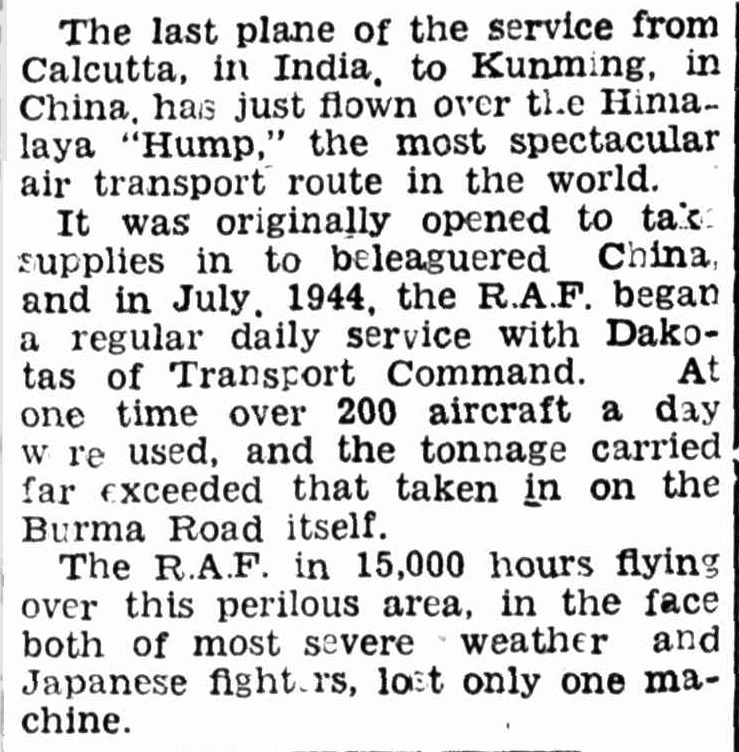
LAST PLANE OVER "THE HUMP" (1946, February 4). Singleton Argus (NSW : 1880 - 1954), p. 1. Retrieved from http://nla.gov.au/nla.news-article82354805
We then went over to Baroda and the Maharajah of Baroda, the wealthiest man in the world at that time, and the Officers were allowed to use his club, which was nice.
That was basically it for our Far East secondment. We did more supplying into Karachi but people were being demobbed by then. We all had to take jobs in other areas as people were being sent home. I was posted down to be second-in-command to a group called the Standing Committee of Adjustments in Bombay. This was an unpleasant job as it involved going through the belongings of deceased service personnel to sort out what could be sent back to their families, and what was inappropriate.
I was only there a couple of months, but another hot place – we lived with prickly heat and rashes.
I was demobbed in November 1946 – ending 5 years in total in the RAF.
Coming Home and Moving to Australia
Where did you come home to?
We landed up in Scotland, as we sailed back on one of the Empress series boats – not as big as the Queen Elizabeth or Mary, but pleasant.
You were reunited with your family just before Christmas 1946 then?
Before we were demobbed we were sent down to Harrogate, which is in Yorkshire, and had to spend about a week there. They gave us demob suits and then home – I just went back to North Wembley-Middlesex.
And did you meet up with your teenage romance girl again?
Yes; eventually. I had two wonderful women in my life. Jo was my last one and I had the last 38 years of my life with Jo – she was my sweetheart when we were teenagers. Something happened and we separated.
During that time I met another lady, Wendy, with whom I had my family, including Debbie. That lasted for 34 years – things happen, but they were both wonderful women.
I’m now a great-grandfather.
What field did you go into after the war?
I came from a family of three sons, I have two brothers and one sister. We had a very high-achieving family. My eldest brother was a very well-known in England, Sir Howard Smith. He was the British Ambassador to Moscow and Czechoslovakia and other places. He was also the British representative in Northern Ireland when there were troubles with the IRA. He was sent in to all the trouble spots.
He was a genius at school and won a state scholarship to the Regent Street Polytechnic in London (taking the examination a year early) and then, a year before the Second World War, an Exhibition in Mathematics to Sidney Sussex College, Cambridge.
After only a year at Cambridge he was drafted into the mathematicians and intellectuals at Bletchley Park who were tasked with breaking German cyphers. He became part of a close-knit team playing, in the words of one participant, "the frenetic equivalent of blindfold three-dimensional chess". He helped to supervise the "Bombes" in Hut 6 - machines built to mirror Germany's "Enigma" cypher device. There’s been a movie made about all that.
When he was British ambassador to Moscow the British Prime Minister contacted him directly and said ‘look we’ve got problems in MI5, there’s a suspected spy in it and we’re not sure who it is. The present Head of MI5 is retiring and we don’t want to promote anybody from inside it, so we’re withdrawing you from Moscow and you will take over’.
My next brother became a Headmaster and couldn’t go any higher, so that was it for him; that’s what he wanted to do.
My sister was a topline ballerina, who danced under the name ‘Beryl Howard’. She trained at the Sadler’s Wells school and, while still a student, had the opportunity to be on stage in 1946 for the reopening of the Royal Opera House after the war with The Sleeping Beauty. She danced with the Anglo-Polish Ballet as a soloist during the war. Following her retirement from the Ballet Rambert she taught ballet for the Inner London Education Authority, which was quite well-known in London.
I was the black sheep of the family in some ways because none of the others did sport.
So when I came out I could either go back to St. Andrews University to finish a degree or do something else. I decided to do something else, and trained up to be a Chartered Surveyor. To do that I had to become an external student of London University and also take Articles with a firm of Catered Surveyors, who were situated adjoining Westminster Abbey. We were in a building that was about 500 or 600 years old, it was so ancient. We were right amongst it all with the House of Commons just around the corner.
I got my Degree and joined the Government, the Department of Inland Revenue, and became a District Valuer. I then got itchy feet, and had met an Australian who told me how marvellous it was out in Australia, and how they were looking for Chartered Surveyors.
I went to my Institute and they told me, ‘look we have a gentleman here who is looking for someone to come out (to Australia) and eventually take over his company in Sydney. This was an old established company called ''Richard Stanton’s'' – I think they’d been going for around 80 years by then. They were based in Pitt Street, his father had created the suburb of Haberfield and Rosebery, so they were quite well-known in this area.
We came out as ‘Ten Pound Poms’ in 1962, right towards the end of that scheme. All 3 children and my first wife Wendy – Debbie was only 2 years old then, Caz was 4 and Michael 7.
We were lucky because John Stanton, the gentleman who was bringing me out to join him, was friendly with a chap who was chairman of P&O, and it was the P and O Oriana. He arranged for us to have a nice cabin, so we lived in luxury although it was only £10.
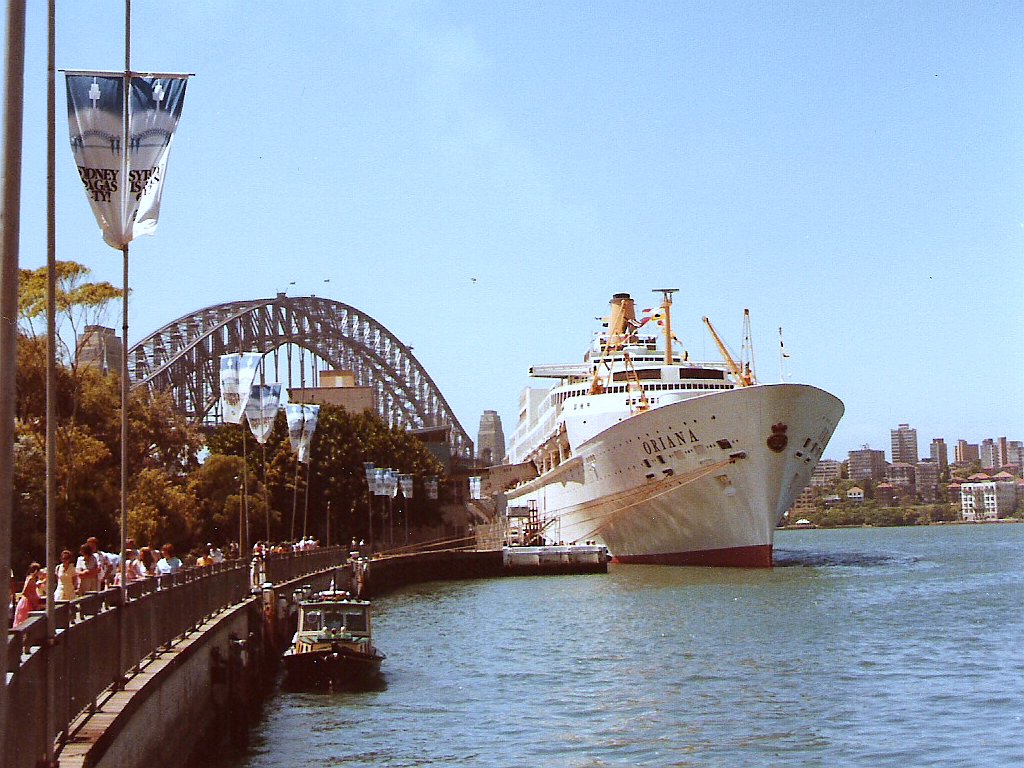
Oriana, seen alongside in Sydney, Australia. Photo: Dashers
They rented a house for us just outside of the Sydney CBD in the inner West, not far from Haberfield. We were there for a few months while we looked around for a house and then bought a home in Pymble. It was a small house, we had to build bits all around it, but we stayed there really until I met my second wife again. The kids were all brought up in Pymble – the girls went to Ravenswood and Michael went to Newington College.
Around 6 years later with Stanton’s I became Managing Director, then Chairman. We had a big client, an international company called ''Taylor Woodrow'', who were a big construction firm – they gave advice on the Opera House – and built over a thousand homes in Western Australia. Their boss was a bloke called Lord Taylor and he used to come out and we had a fairly close liaison, I used to handle all their stuff.
He said one day, ‘look, I want to expand what we do in Australia and I want someone to take over – will you do it?’. So I switched and became Managing Director of Taylor Woodrow Australia. I saw my time out with them.
So did you like it here or did you want to head back to Old Blighty?
No; I’ve never looked back. I’ve always said this is the most fantastic place in the world to live. There’s every opportunity for anybody who wants to work hard, they will succeed here. I’m so happy for my family – if they had stayed in England it may not have been so good as there are some real challenges there now. They’ve all done well.
What age were you when you retired?
69.
What is the secret to being so healthy and happy for so long?
Tennis – I’ve played tennis all my life.
Debbie (daughter): chocolate, too much chocolate.
Roy: I’m a great lover of chocolate and that’s the other thing I put aging well into old age down to – my intake of chocolate. I always feel fit, I always feel well. My hearing is bad and my sight is bad, but that is just normal wear and tear over the years.
But you have to keep your body healthy – I was playing tennis right through until I was 90. I was playing competition tennis to the age of 88. The tennis kept me going, got me bodily fit, it keeps the mind active. Now, I can’t keep my body fit but I can keep my mind fit; I spend hours on the New York Times puzzles on my computer. I do Spelling Bee every night.
Debbie: did you say your mum lived to be 105? Yes; so there’s genes as well.
Roy: but I’ve always kept myself fit.
Debbie: and eaten lots of chocolate, still do.
What are your favourite places in Pittwater and why?
I love it here, in Avalon Beach. To be honest, Avalon to me is possibly the best place of all. I like Palm Beach, I like Newport. Why?; it’s the community – the community here is incredible. All the neighbours are so friendly, we all get together, they all came to my 100th party, just lovely. Debbie teaches pottery and I took up that at age 98 and joined her class, many of whom are our neighbours. I’m the only man in the class of ladies so they have to behave themselves. As a favourite I’d have to say Avalon because it’s got everything; I like the little shopping centre although they could improve the parking – but it’s a wonderful community and wonderful area.
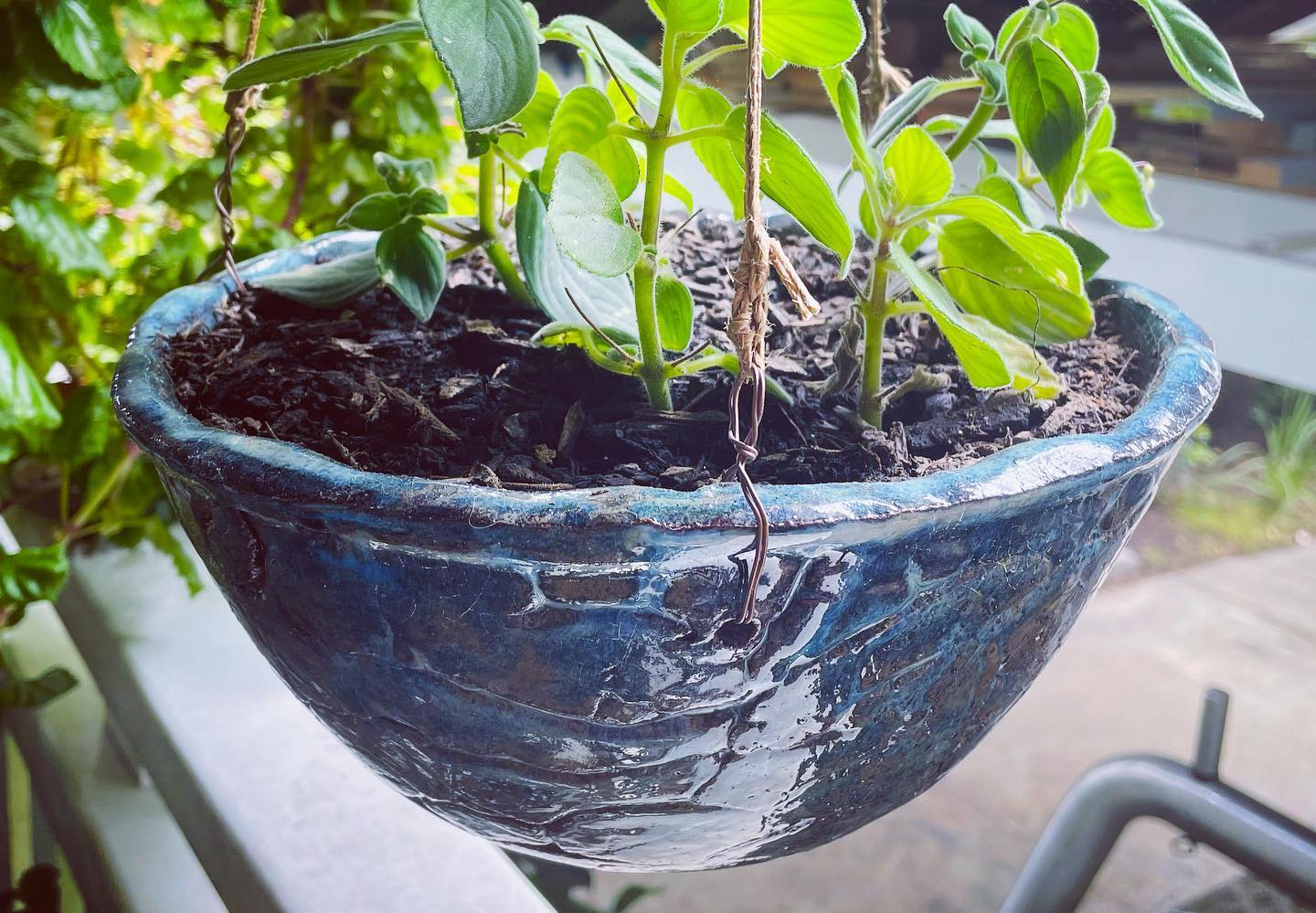
one of Roy's ceramic creations - functional and beautiful
What is your ‘motto for life’ or a favourite phrase you try to live by?
I usually say you could wrap it up in a four-letter-word; Love.
You have got to love what you’re doing, you’ve got to love people, you’ve got to love everything. You have got to try to be a loving person. I’m usually surrounded by loving people. I have a loving family, and I think that if you can create a loving atmosphere to live in, and try to keep that level up, then you are going to be very happy. It’s not easy sometimes, sometimes you have to strive – but to me that was the most important thing; to try to be a loving person, to love things, to love animals.
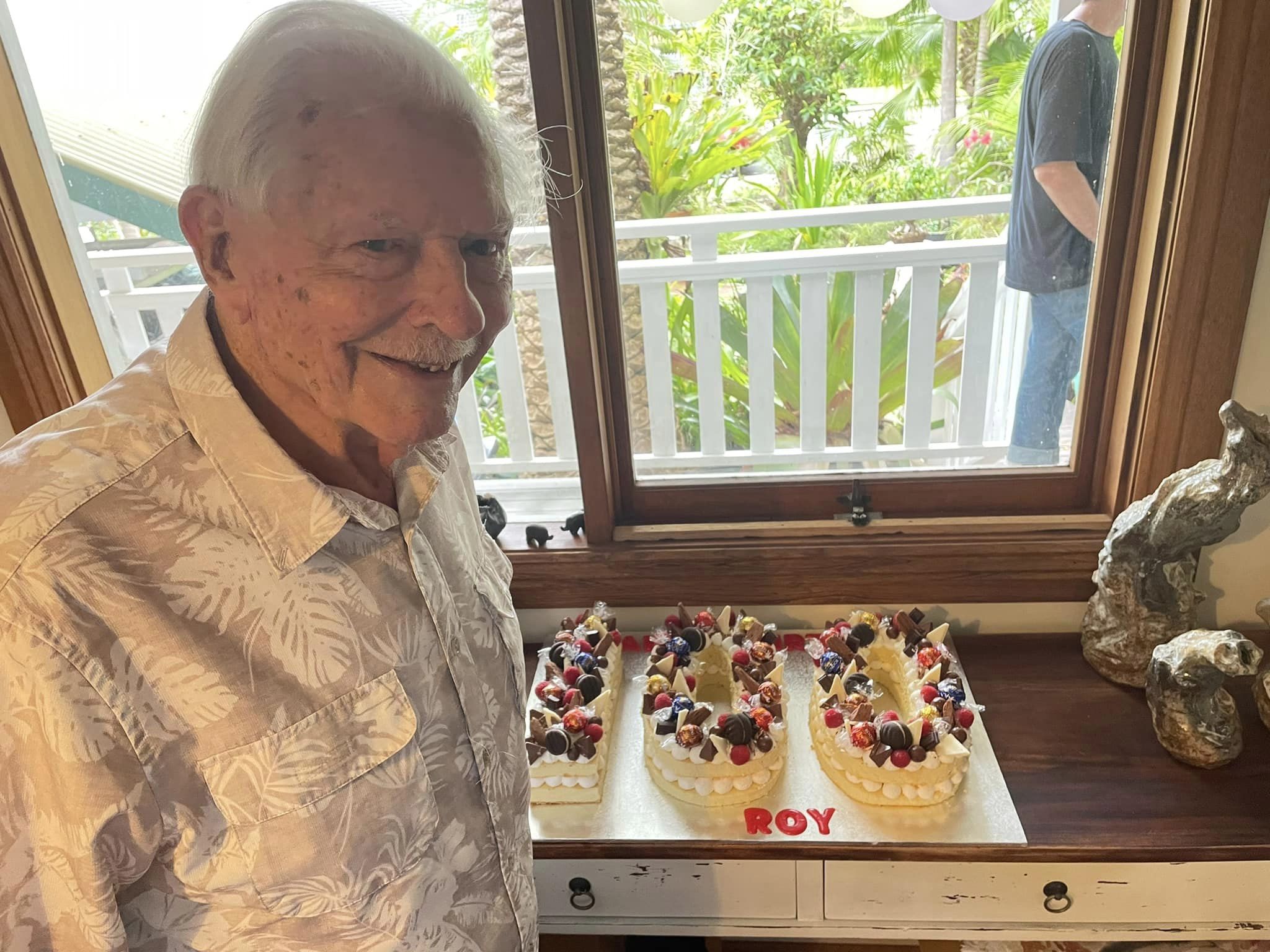
Roy with his 100th birthday cake, topped with lots of health-food chocolate. Photos: Debbie Mundell
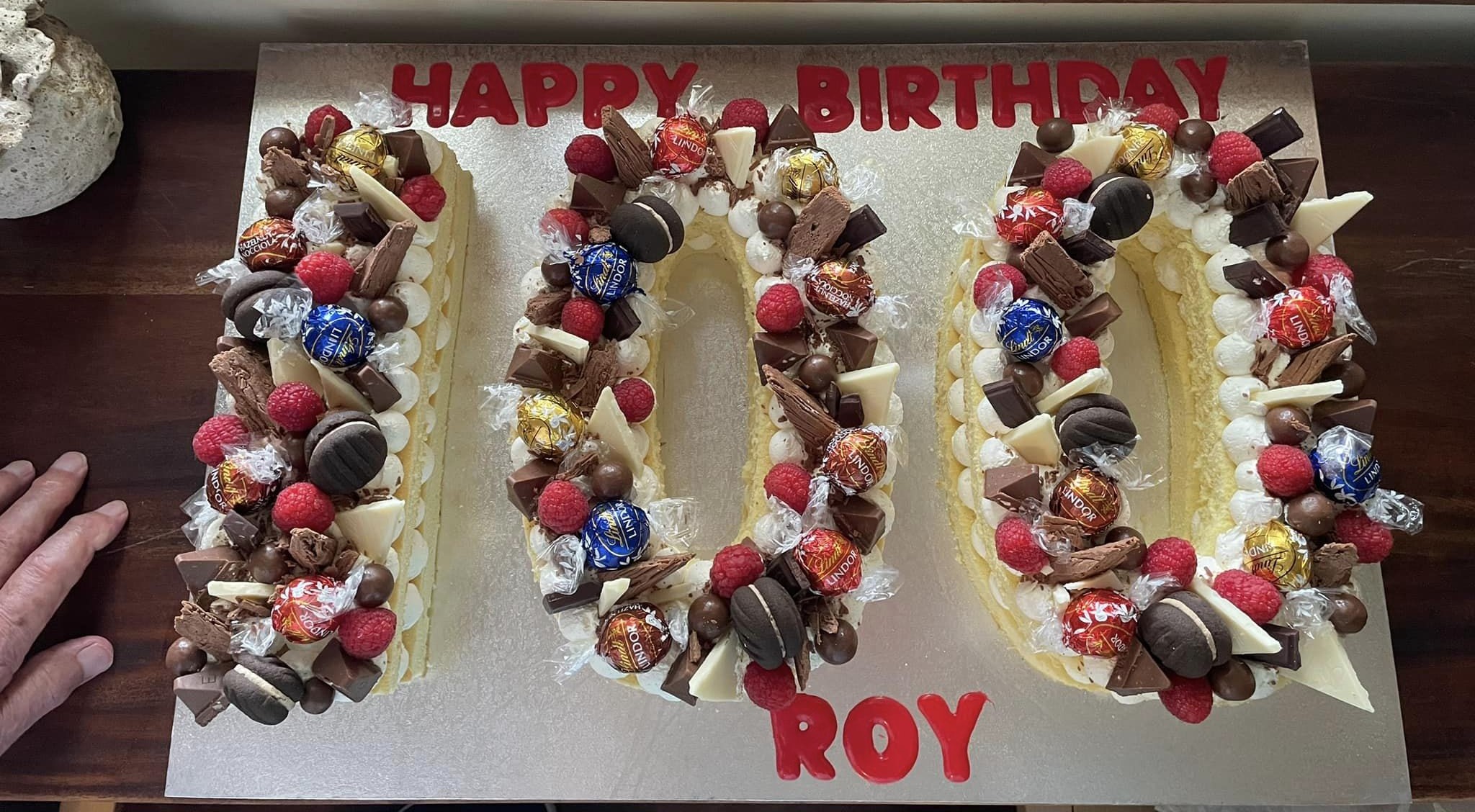
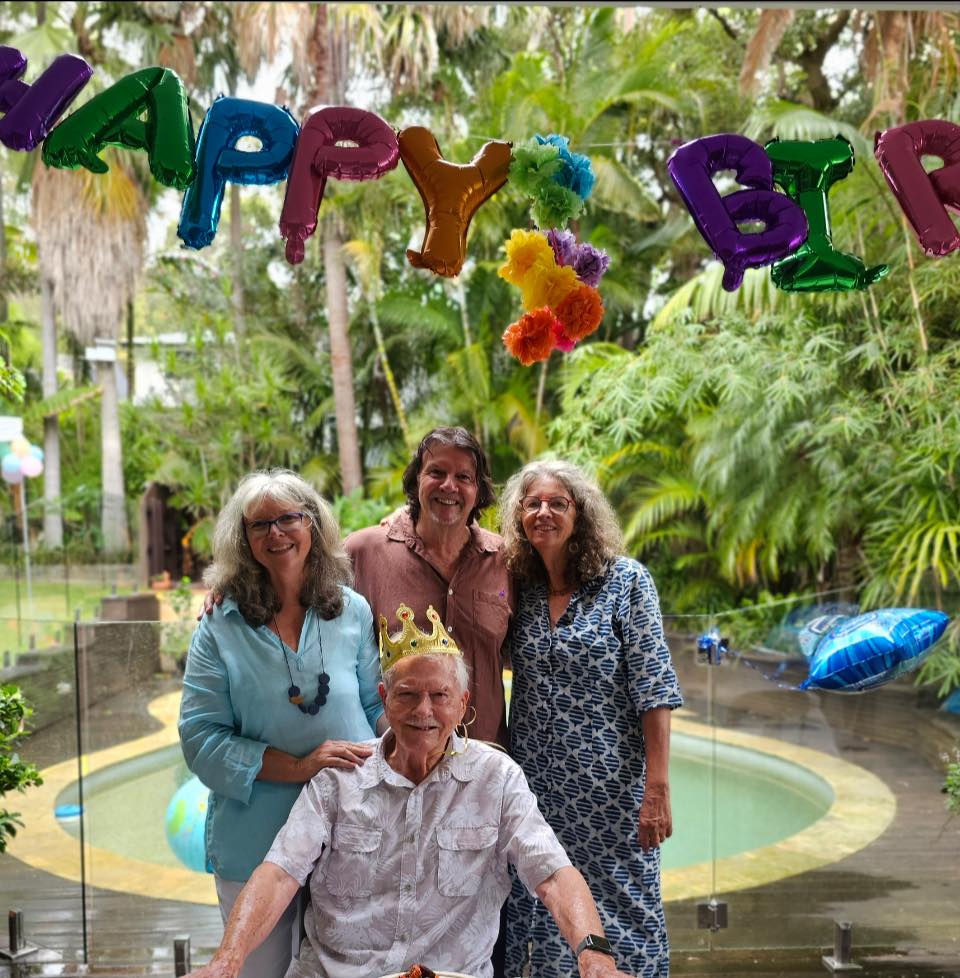
Roy with his children at his 100th Birthday party
100th Birthday congratulations cards:
Notes
4 BFTS was based at Falcon Field Arizona from 16 June 1941 to 10 September 1945. During that time 27 courses were trained involving over 2300 pilots.
The 'Arnold Scheme' (1941-43) and the British Flying Training Schools (1941-45), with the co-operation of Squadron Leader Mills DFC and President Roosevelt, enabled the setting up of flight training in the USA for RAF pilots to train alongside American servicemen. The Lend-Lease Act was instrumental in paving the way for training British pilots and aircrew in the USA and in total seven BFTS were set up in the USA in Texas, Oklahoma, Arizona, California and Florida.
There were minimum requirements for each airfield used. Each BFTS was required to be one mile square with two runways and a control tower. PT-17A (Stearman) and AT-6A (Harvard) aircraft were mainly used for training giving RAF pilots an opportunity to train on more suitable aircraft than the Tiger Moths used in the UK and in an environment where they would not be under attack.
The BFTS were RAF establishments with the Commanding Officer, Adjutant, CFI’s and PT instructors being RAF personnel. American civilians became instructors trained to RAF standards.
Training usually lasted about 28 weeks and involved 3 stages on different aircraft: Primary on the Stearman, Basic on the Vultee and Advanced on the Texan. As student pilots successfully completed each stage they were promoted. At the end of the Primary stage, cadets were promoted to the rank of Leading Aircraftman. By the time Advanced training was completed, cadets graduated with the presentation of their Pilot's Wings and were promoted to Sergeant. Approximately the top third of each class was commissioned as Pilot Officers.
Once flying training was completed, graduates returned to Great Britain for reassignment in the skies over Europe. Courses 26 and 27 were cut short by the end of World War 2 and the cadets returned home without graduating.
Sadly, 23 RAF cadets lost their lives in cadet training and are honoured every year in a Memorial Service at the City of Mesa Cemetery.
From: https://www.americanairmuseum.com/archive/unit/4-british-flight-training-school
9 Mar 2024 — Just after midday a Vintage Boeing-Stearman A75N1 inverted during Landing at Shellharbour Airport. NSWA Boeing-Stearman A75N1 biplane ended its landing at Shellharbour Airport in an unexpected position, coming to rest inverted on the runway. The incident, which caused substantial damage to the aircraft’s left wing and horizontal stabiliser, saw the pilot and a female passenger in their 50s emerge remarkably unscathed.
The Hollywood Canteen operated at 1451 North Cahuenga Boulevard in the Los Angeles, California, neighborhood of Hollywood between October 3, 1942 and November 22, 1945, as a club offering food, dancing, and entertainment for enlisted men and women, who were usually on their way overseas during World War II. Even though the majority of visitors were US servicemen, the canteen was open to allied countries as well as women in all branches of service. Their tickets for admission were just their uniforms, and everything at the canteen was free of charge.
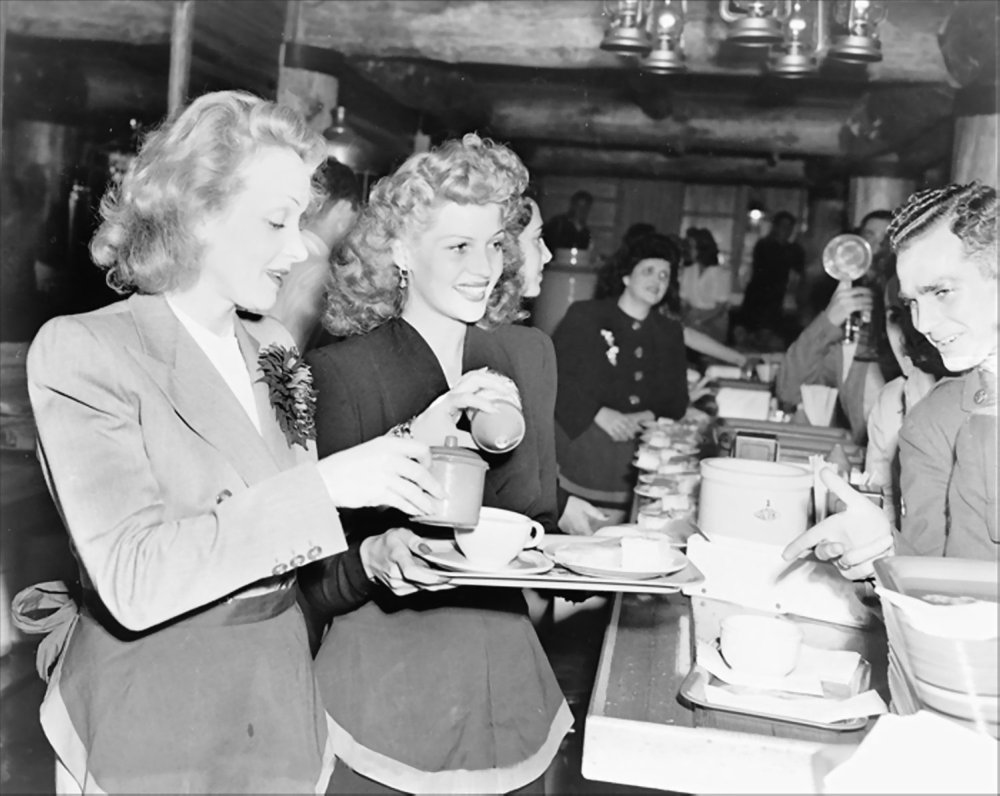
Marlene Dietrich (left) and Rita Hayworth serve food to soldiers at the Hollywood Canteen in 1942.
Dame Gracie Fields DBE OStJ (born Grace Stansfield; 9 January 1898 – 27 September 1979) was a British actress, singer and comedian. A star of cinema and music hall, she was one of the top ten film stars in Britain during the 1930s and was considered the highest paid film star in the world in 1937. Fields was known affectionately as Our Gracie and the Lancashire Lass and for never losing her strong, native Lancashire accent. She was appointed a Commander of the Order of the British Empire (CBE) and an Officer of the Venerable Order of St John (OStJ) in 1938, and a Dame Commander of the Order of the British Empire (DBE) in 1979.
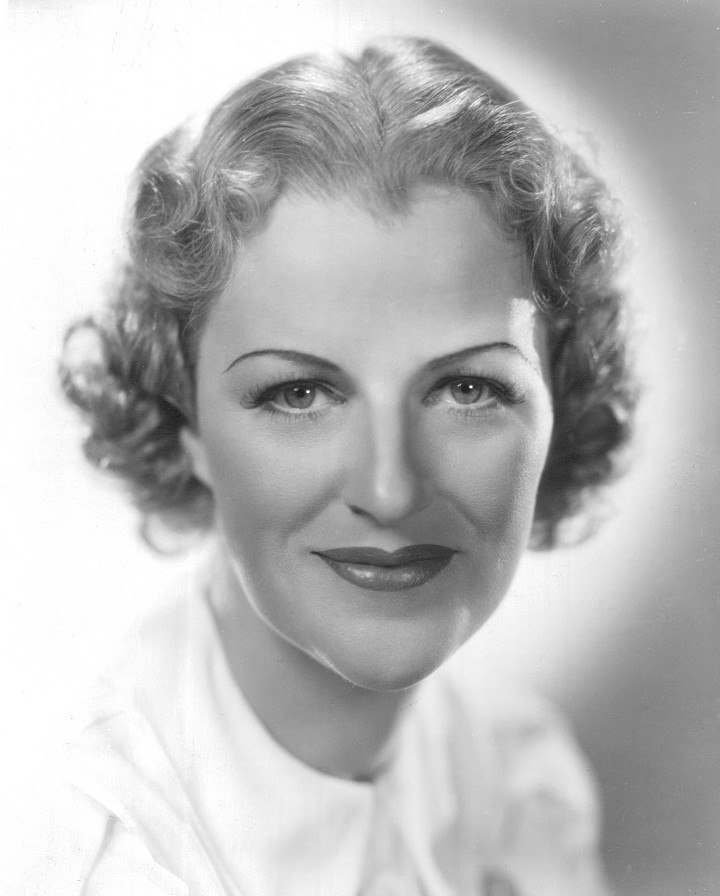
Gracie Fields in 1937.
In 1939, Fields suffered a breakdown of her health and went to Capri to recuperate. World War II was declared while she was recovering in Capri, and Fields – still very ill after cancer surgery – threw herself into her work and signed up for the Entertainments National Service Association (ENSA) headed by her old film producer, Basil Dean. Fields travelled to France to entertain the troops in the midst of air-raids, performing on the backs of open lorries and in war-torn areas. During the war, she also paid for all servicemen and women to travel free on public transport within the boundaries of Rochdale. Fields travelled to Chester with serviceman Harrison after he had watched her perform in France. She stayed with his family of 9 as a guest in their small 2 up 2 down house.
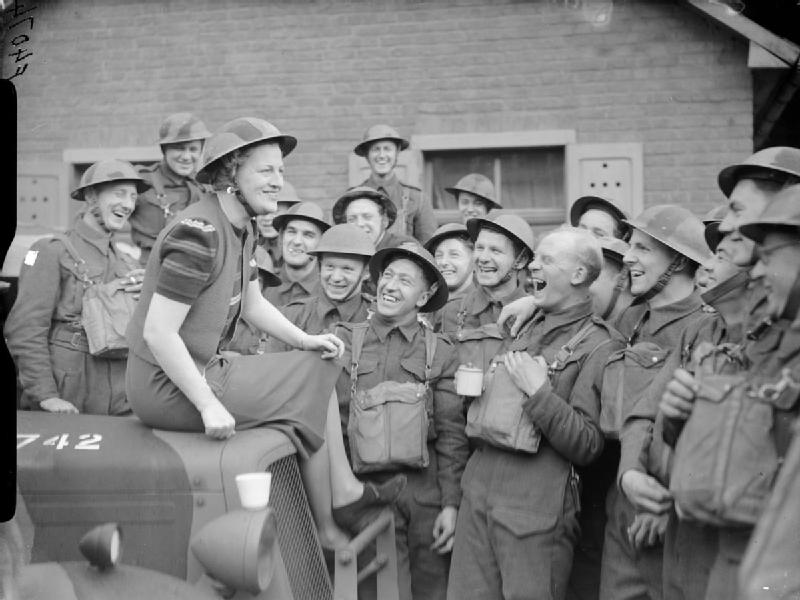
Fields shares a joke with troops in a village near Valenciennes, France, April 1940. Photo: Taylor E A (Lt), War Office official photographer. This photograph F 4074 comes from the collections of the Imperial War Museums.
Following her divorce from Archie Pitt, she married Italian-born film director Monty Banks in March 1940. However, because Banks remained an Italian citizen and would have been interned in the United Kingdom after Italy declared war in 1940, she went with him to North America, possibly at the suggestion of Winston Churchill who told her to "Make American Dollars, not British Pounds", which she did, in aid of the Navy League and the Spitfire Fund. She and Banks moved to their home in Santa Monica, California.
RMS Queen Mary is a retired British ocean liner that sailed primarily on the North Atlantic Ocean from 1936 to 1967 for the Cunard Line and was built by John Brown & Company in Clydebank, Scotland. Queen Mary, along with RMS Queen Elizabeth, was built as part of Cunard's planned two-ship weekly express service between Southampton, Cherbourg and New York. The two ships were a British response to the express superliners built by German, Italian and French companies in the late 1920s and early 1930s.
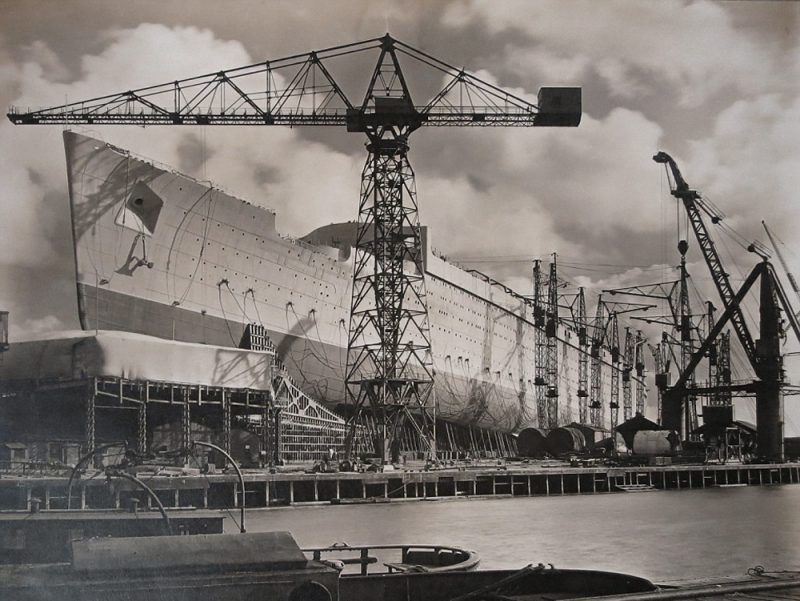
Queen Mary under construction at Clydebank, c. 1934
In August 1942 the Queen Mary transported an entire army division of 15,125 (plus 863 crew) a first for any ship, and in December of the same year carried 16,082 American soldiers from New York to Great Britain a record for the most passengers ever transported on one vessel. During the war, 12 bunks occupied the space normally allotted to one bed aboard the great ship.
RAF Hemswell - No. 150 (Bomber) Squadron RAF equipped with the Avro Lancaster, No 1 Group RAF. The squadron was disbanded in November 1945. November 1944, No. 170 Squadron
On 19 March 1940 RAF Hemswell-based Handley Page Hampdens of No. 61 Squadron RAF were the first Bomber Command aircraft to drop bombs on German soil during the Second World War. The target was the Hörnum seaplane base on the northern Germany coast.
Hemswell operated as a dual site with a nearby overflow airfield at RAF Ingham. RAF Ingham was a grassed field landing ground with few buildings or facilities. Between 1941 and 1943 the Polish bomber squadrons (No. 305 Polish Bomber Squadron, No. 301 Polish Bomber Squadron and No. 300 Polish Bomber Squadron) used the airfield for their Wellington operations.
With the arrival of the Avro Lancaster, Hemswell took on a training role, becoming the home to No. 1 Lancaster Finishing School. This school was tasked with giving Lancaster experience to aircrews who had just finished their training at a Heavy Conversion Unit prior to posting to an operational squadron. During 1944, as Lancasters were then being used at Heavy Conversion Units, the Lancaster Finishing Schools were disbanded and Hemswell again took on an operational role. No. 150 and 170 squadrons took up residence and commenced flying bomber operations until the end of the war. The film "Night Bombers" was shot at Hemswell during this period.
No. 38 Group RAF was formed on 6 November 1943 from the former 38 Wing with nine squadrons as part of Transport Command. The predecessor of 38 Group was No. 38 Wing RAF, initially formed on 15 January 1942 from 296 and 297 Squadrons and based at RAF Netheravon in Wiltshire under Group Captain Sir Nigel Norman. 295 Squadron was additionally formed at Netheravon on 3 August 1942. To these were added 570, 298, 299, 190, 196, 620 Squadrons to form No. 38 Group on 11 October 1943. At that time four squadrons were equipped with Albemarles (295, 296, 297, 570), one with Halifaxes (298) and four with Stirlings (299, 190, 196, 620). A further Halifax unit, 644 Squadron, was added in February 1944.
During 1943, changes of all aircraft types and operational bases were made. Nevertheless 295, 296 and 297 Squadrons were heavily involved that year in operations Beggar, Ladbroke and Fustian, during the invasion of Sicily. From February 1944 many sorties were made over mainland Europe in support of Special Operations Executive and detachments of the Special Air Service.
But by 5 June 1944 the group’s updated resources had been fully redeployed between RAF Brize Norton, RAF Fairford, RAF Harwell, RAF Keevil and RAF Tarrant Rushton in preparation for Operation Overlord, the invasion of Europe. From then to 16 June the Group was fully involved in operations Tonga (the delivery of paratroop-filled gliders at the onset of Overlord) and Mallard (the delivery of the main airborne forces and their equipment by glider).
In September 1944 the group was called upon to ferry airborne troops for Operation Market Garden, the abortive attempt to capture the Rhine bridge at Arnhem. Following that operation there was further reorganisation; the Group Headquarters moved to Marks Hall, Essex in October 1944 and the squadrons were redeployed to RAF Earls Colne (296 and 297), RAF Rivenhall (295 and 570), RAF Great Dunmow (190 and 620), RAF Wethersfield (later to RAF Shepherds Grove) (196 and 299) and RAF Woodbridge (298 and 644). 190 Squadron remained temporarily at RAF Fairford. On 10 March 1945 161 Squadron at RAF Tempsford also came under 38 Group control.
On 24 March 1945 the squadrons were fully employed in delivering airborne troops to the far bank of the Rhine as part of Operation Varsity, an operation which proved costly in terms of aircrew lives lost.
After the war most 38 Group squadrons were either disbanded or relocated to the Far East and the HQ moved to RAF Upavon. 295 and 297 Squadrons merged and moved to Fairford. 38 Group became part of RAF Transport Command on 1 June 1945.
No. 298 Squadron was a Royal Air Force special operations squadron during the Second World War. No. 298 Squadron was formed on 24 August 1942 at RAF Thruxton from a nucleus of 297 Squadron as a special operations squadron, equipped with the Armstrong Whitworth Whitley. The squadron was however not required for operations, so the formation was suspended and the squadron was disbanded on 19 October 1942.
The squadron was re-formed on 4 November 1943 at RAF Tarrant Rushton, from 'A' Flight of 295 Squadron, with the Handley Page Halifax. It trained to air-tow the big General Aircraft Hamilcar glider, but began operations in February 1944 in its original role, dropping SOE agents. On 16 March 1944 298 Squadrons 'C' Flight split off, to form 644 squadron.
During the Normandy landing the squadron air-towed both the Airspeed Horsas and the Hamilcars to landing-zones around the beach head. An unusual operation involved parachuting jeeps which had been carried underneath the Halifax. The squadron then returned again to SOE duties. In between the SOE duties the squadron air-towed Hamilcar and Horsa gliders for the Arnhem landing (Operation Market Garden). The squadron moved in March 1945 to RAF Woodbridge, England to air-tow gliders for the Rhine crossing (Operation Varsity). After Operation Varsity the squadron flew normal supply and transport duties.
In July 1945 the squadron moved to Raipur, in the Central Provinces, to provide transport support to the Army. In March 1946 the squadron was involved in rice-dropping sorties from Meiktila, Burma to the starving population in the jungle areas. The squadron disbanded at Mauripur, Sindh, British India (Now Pakistan Air Force Base Masroor) on 21 December or 30 December 1946.
The RAF Far East Air Force was the Command organisation that controlled all Royal Air Force assets in the east of Asia (Far East). It was originally formed as Air Command, South East Asia in 1943 during the Second World War. In 1946, this was renamed RAF Air Command Far East, and finally Far East Air Force in June 1949.
Unlike in Europe, war ended very unexpectedly in the Far East. The dropping of the atomic bombs on Hiroshima and Nagasaki, combined with the American blockade of Japan, and the Soviet entry into the war on 9 August 1945 finally shocked the Japanese into suing for peace. Once peace came, there was a period of euphoria within the RAF units, but the forces in the region came back down to earth with a bump a few days later.
The four major RAF formations under HQ ACSEA in India and Ceylon at the end of the war were HQ BAFSEA; AHQ Burma; HQ 222 Group at Columbo, controlling all operational squadrons in Ceylon, largely carrying out maritime duties; and 229 Group, a Transport Command group located in New Delhi. 222 Group disbanded by being renamed AHQ Ceylon on 15 October 1945; it inherited six Liberator squadrons (Nos 99, 356, 203, 8, 160, and 321 RNLAF); four Sunderland squadrons (205, 209, 230, and 240); and No. 136 Squadron with Spitfires. After HQ BAFSEA was merged with AHQ India, twelve RAF squadrons (225 Group: Nos 5, 30 at Bhopal, 45 at St Thomas Mount; 227 Group: 298 Squadron at Samungli with a detachment at Chaklala; No. 228 Group RAF: 176, 658 AOP, 355 at Digri, 159 at Salbani; 229 Group: 353 and 232 at Palam; and 10 and 76 with Dakotas at Poona) remained in India after 1 April 1946, and AHQ India was placed under joint command of the Indian Government and the Air Ministry (Lee Eastward 65-69, Appendix B, 261).
Shrimant Maharaja Sir Pratap Singh Rao Gaekwad (29 June 1908 – 19 July 1968), who belonged to the Gaekwad dynasty of the Marathas, was the ruling Maharaja of Baroda.
Aircraft operated by no. 298 Squadron RAF
- August 1942 October 1942 Armstrong Whitworth Whitley Mk.V
- November 1943 November 1944 Handley Page Halifax Mk.V
- September 1944 July 1945 Handley Page Halifax Mk.III
- March 1945 December 1946 Handley Page Halifax A.7
Bases and airfields used by no. 298 Squadron RAF
- 24 August 1942 19 October 1942 RAF Thruxton, Hampshire
- 4 November 1943 21 March 1945 RAF Tarrant Rushton, Dorset
- 21 March 1945 24 March 1945 RAF Woodbridge, Suffolk
- 24 March 1945 5 July 1945 RAF Tarrant Rushton, Dorset
- 5 July 1945 15 July 1945 en route to British India
- 15 July 1945 9 December 1945 RAF Raipur, Chhattisgarh, British India; Dets. at RAF Akyab, Burma and RAF Alipore, Bengal, British India
- 9 December 1945 20 May 1946 RAF Digri, Sindh, British India; Dets. at RAF Negombo, Ceylon; RAF Meiktila, Burma and RAF Chaklala, Punjab, British India
- 20 May 1946 24 July 1946 RAF Baroda, Gujarat, British India
- 24 July 1946 21 December 1946 RAF Mauripur, Sindh, British India; Det. at RAF Risalpur, North-West Frontier Province, British India
Sir Howard Frank Trayton Smith GCMG (15 October 1919 – 7 May 1996) was a British diplomat who served as Director General of MI5 from 1978 to 1981. Educated at Sidney Sussex College, Cambridge, Smith worked at Bletchley Park during World War II and later became the British ambassador to Moscow. At college in Cambridge, Smith was a contemporary of Asa Briggs, playing chess with him and recommending Briggs to fellow Cambridge mathematician Gordon Welchman for service in Hut 6.
Smith joined the Foreign Office in 1939. From 1946 to 1950, Smith served in the Foreign Service in Oslo and Washington. In 1953, he was Consul in Caracas; between 1961 and 1963, he was Counsellor of State in Moscow. Smith served as Ambassador to Czechoslovakia from 1968 to 1971 and later served as Ambassador to the Soviet Union in Moscow from 1976 to 1978.
In 1978 Smith was unexpectedly appointed Director General (DG) of MI5, the United Kingdom's internal security service, by Prime Minister James Callaghan, serving until March 1981. He was the first DG from a background in the diplomatic service. Callaghan later explained that he: wanted 'to bring someone into the office from a different culture'.
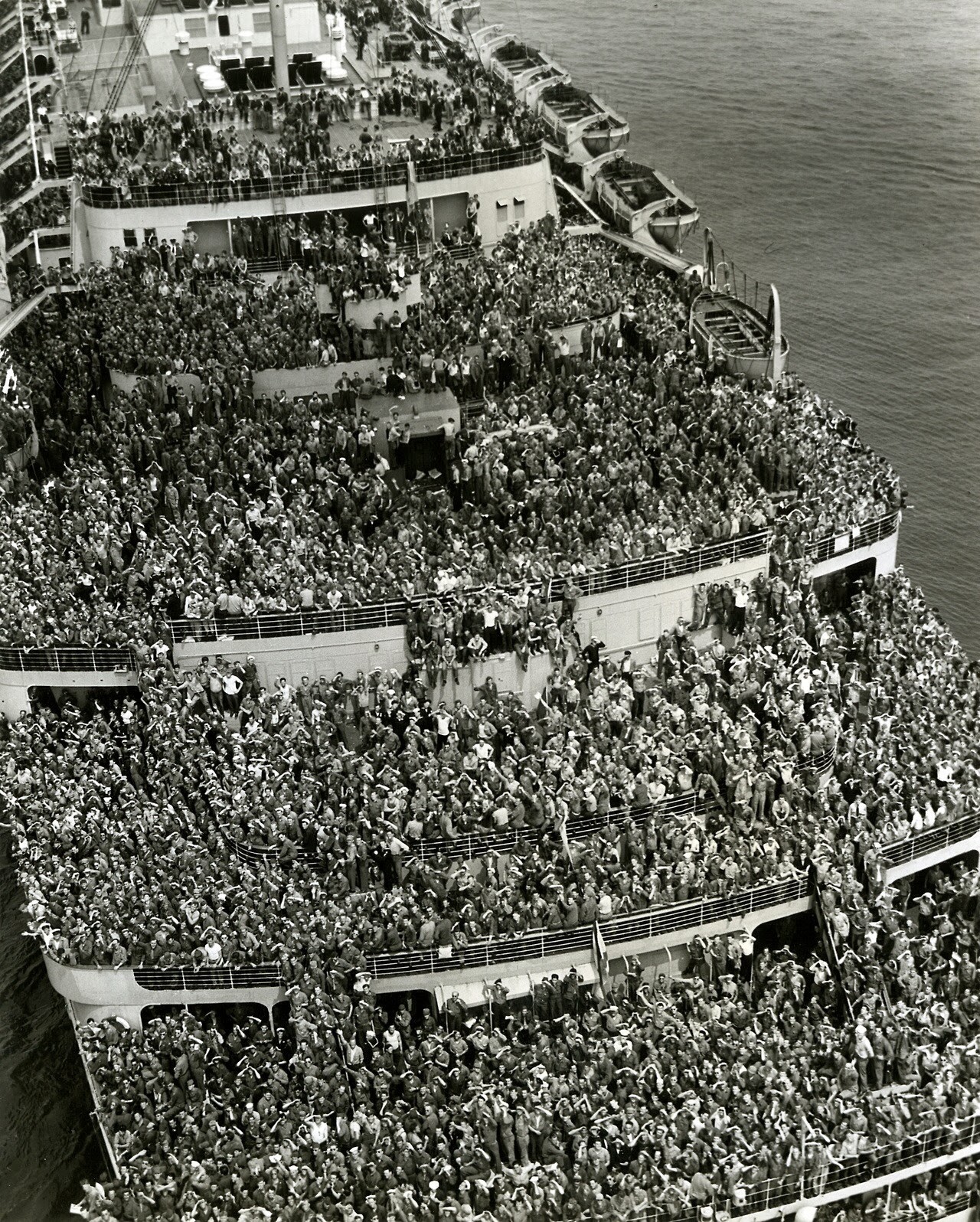
Ship, ocean liner, bringing American troops back to New York harbour after V-Day, 1945
